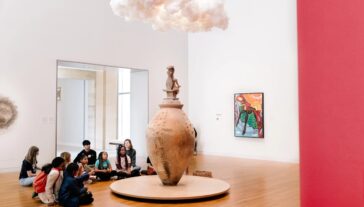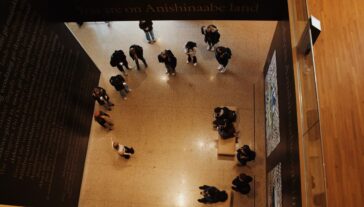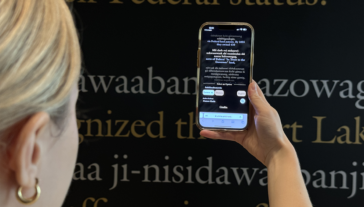At UMMA, We Ask This 3-Part Question That Changes the Way People Think About Art

You might come to the U-M Museum of Art with preconceived notions about what kind of art you’ll see, or what your experience here will be like. But, we’ll let you in on a little secret: there is no exact right way to visit UMMA–or really, any other museum—because there’s no right way to look at art.
You might arrive, grab a map, and try to step foot into every room–or just focus on a few collection areas you know you like, like Asian ceramics or modern/contemporary paintings. Sounds great! You might come in all jazzed up about a new exhibition–or you might come in with no idea what’s currently on view but you’re ready to explore. Heck yeah! You might have multiple art history degrees and be able to spot errors in on our wall text or object labels (uh, but seriously, if you think you see any then please let us know)–or you might have zero interest in art at all, actually, but you were dragged in here against your will by someone who does. Whatever your deal is, we’re glad you’re here! All visits are good visits.
So, no matter your age, your interests, your racial identity, your gender identity, your career, or your educational background, the good folks in UMMA’s education department have a patented (okay, not really) series of prompts to help you get the most out of your visit. Just ask yourself these three questions and you’ll change the way you think about art:
1) What do you see? (Literally, just list what you see)
2) What does it make you think of? (There are no wrong answers!)
3) How does that relate to a larger theme?
Dave Choberka, UMMA’s Mellon Foundation Curator for University Learning and Programs, says that the first 2 questions are ”pretty standard practices of visual analysis in museum education.” The unique thing, he says, is the 3rd point–“the goal of connecting discussion to a larger theme.”
Choberka, who primarily works with UM students visiting the Museum as part of a class, says he learned by watching now-retired UMMA educators lead tours. “When a student would make an observation, they would say, What do you see that makes you say that? or some variation thereof,” he says. “They would also point at specifics in the artworks and ask, What do you think is going on here?” Choberka joined UMMA in 2012, and estimates that he’s led over 2,000 tours since then–including the popular Subject Matters series.
At a recent Subject Matters tour of Clay as Soft Power, Choberka prompted the group to try this exercise with John Stephenson’s 2006 sculpture, Screw Ball, a large spherical piece hanging from a rope. What do we see? Rope. Bubbles. A hole through the middle. Some sort of debris–leaves, or maybe paper scraps–settled inside the center of the piece (not surprising, noted curator Dr. Natsu Oyobe, since prior to coming to UMMA as a loan, this piece had been stored in a barn). What does it make us think of? A wrecking ball. Baseball. Lynching. How does that connect back to the larger theme of today’s discussion? Experimentation. Wrecking expectations. Letting things go.
Two weeks later, Choberka led another Subject Matters tour themed around the class ALA350: Predicting the Future. He prompted the group to look at one of his personal favorite pieces, the mixed-media work Line A-C by Buky Schwartz. What do we see? Yarn, twisting and turning all over the frame. Variegated colors that repeat. Points A and C, but no B. What does it make us think of? The afterlife. Chaos. Freedom versus fate. How does that connect back to the larger theme of today’s discussion? History repeating itself. Moving to a new country for new opportunities. The gradual accumulation of everything that makes up a life.
You can try this exercise yourself, even without visiting UMMA as part of a group. Try coming up with your own “theme” for your visit. What issues and ideas have been bouncing around your brain these days? What are you passionate about? What are you struggling with? What interpersonal situations are you in the midst of? All of these filters can make you notice details in artwork that you otherwise might not.
The beauty of this 3-part method is that it can work on anything and everything. The huge sculptures outside UMMA, the funky little inkwells in the open storage room, the current exhibitions about Indigenous sovereignty, contemporary Korean ceramics, or how 18th-century American portraits often obscure the truths about their subjects. Try it at the Kelsey Museum, try it at the U-M Museum of Natural History, try it while looking at the decor in your weird aunt’s bathroom. You just might be surprised by what you find.
More from UMMA



